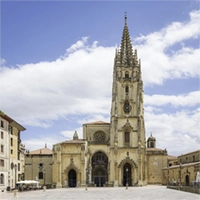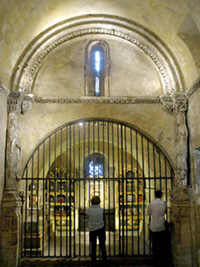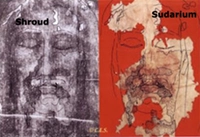
Sudarium of Oviedo
Although less known than the Shroud of Turin, The Sudarium of Oviedo is a relic of considerable importance. One of the relics held by the cathedral in the northern Spanish town of Oviedo, the Sudarium is a piece of cloth measuring approximately 84 x 53 cm. It contains stains that are visible to the naked eye, while more is visible under the microscope. The remarkable thing about this cloth is that both tradition and scientific studies suggest that the cloth may have been used to cover and clean the face of Jesus after His crucifixion.

Such a cloth was described in the gospel of John 20:6-7. John clearly differentiates between this smaller face cloth, the sudarium, and the larger linen that had wrapped the body.
The history of the sudarium is well documented, and much more straightforward than that of the Shroud. According to this history, the sudarium was in Palestine until shortly before the year 614, when Jerusalem was attacked and conquered by Chosroes II, king of Persia (590 to 628). It was taken away to Alexandria by the presbyter Philip to avoid destruction in the invasion, and then across the north of Africa when Chosroes conquered Alexandria in 616. The sudarium entered Spain at Cartagena, along with people who were fleeing the Persians. The bishop of Ecija, welcomed the refugees and the relics, and surrendered the the relics to Leandro, bishop of Seville.
Saint Isidore was later bishop of Seville, and teacher of Saint Ildefonso, who was in turn appointed bishop of Toledo. When the latter left Seville, he took the chest with him to Toledo where it stayed until the year 718. It was then taken further north to avoid destruction at the hands of the conquering Muslims at the beginning of the eighth century. First kept in a cave now called Monsacro, King Alfonso II had a special chapel built for the chest, called the "Cámara Santa", which was later incorporated into the Oviedo cathedral.

The chest was officially opened in the presence of King Alfonso VI, his sister Doña Urraca, and Rodrigo Díaz de Vivar, (better known as El Cid). The relics in the chest included the sudarium, which has been kept in the cathedral at Oviedo ever since.
Investigations were carried out on the sudarium by the Investigation Team of the Spanish Centre for Sindonology. The stains on the sudarium show that when the cloth was placed on the dead man's face, it was folded over, although not in the middle. From the composition of the main stains, it is evident that the man whose face was covered died in an upright position. The stains consist of blood and edema that collects in the lungs when a crucified person dies, and can come out through the nostrils.
The cloth did not surround the head entirely because the right cheek was almost touching the right shoulder. This suggests that the sudarium was put into place while the body was still on the cross. A second stain was made about an hour later, when the body was taken down. The third stain was made when the body was lifted from the ground later.

Experiments with a model head and the study of the stains show that when the man died his head was tilted seventy degrees forward and twenty degrees to the right. It would appear that the sudarium was pinned to the back of the dead man's head, and that spots of blood in the area were likely from small sharp objects, consistent with the thorns that caused injury all over Jesus' head.
Together with the medical studies analysis of pollen samples taken from the cloth was carried out. It found species typical of Oviedo, Toledo, North Africa and Jerusalem, confirming the historical route described earlier. There was nothing relating the cloth to Constantinople or Europe. Importantly, species of pollen called "quercus caliprimus" were found, both of which are limited to the area of Palestine.
Residues of what is most probably myrrh and aloe have also been discovered on the cloth, ( John 19:39-40). Anthropological study of the stains concluded that the face that had been in contact with the sudarium had typically Jewish features, a prominent nose and pronounced cheekbones.
Coincidence With The Shroud

Truly fascinating evidence comes to light when this cloth is compared to the Shroud of Turin. The first and most obvious coincidence is that the blood on both cloths is of the same group, namely AB positive. The length of the nose has been calculated at eight centimeters, which is exactly the same length as the nose on the image of the Shroud. When the face of the image on the Shroud is placed over the stains on the sudarium, the most obvious coincidence is the exact fit of the stains with the beard on the face. The thorn wounds on the nape of the neck also coincide perfectly with the bloodstains on the Shroud.
Polarized Image Overlay Technique was applied to the sudarium, comparing it to the image and bloodstains on the Shroud. The frontal stains on the sudarium show seventy points of coincidence with the Shroud, and the rear side shows fifty. This very strongly suggests that the Oviedo sudarium covered the same face as the Turin Shroud.
Helping to Time The Shroud
The sudarium has no image, and none of the facial stains of dried or drying blood visible on the Shroud, especially the stain on the forehead in the shape of an inverted three. This, together with the fact that the fingers which held the sudarium to the victim's nose have left their mark, point to a short temporal use of the cloth and and militate against its contact with the body after burial.
Jewish tradition demanded that when the face of the deceased was in any way disfigured, it should be covered with a cloth to prevent people having to see this unpleasant sight. This would certainly have been the case with Jesus, whose face was covered in blood from his injuries and badly swollen from falling and being beaten. It would appear that the sudarium was used before the dead body was taken down from the cross and set aside at the time of burial. This fits in with what we learn from John's gospel, which tells us that the sudarium was rolled up in a place by itself.
The provenance of the Sudarium and its coincident findings with the Shroud of Turin make a compelling case for the ancient origin of the Shroud. Together with the more modern analyses of the Shroud, the Sudarium lends greater weight to the argument that the Turin relic long antedates the age suggested by the C-14 testing performed in the 1980s.
